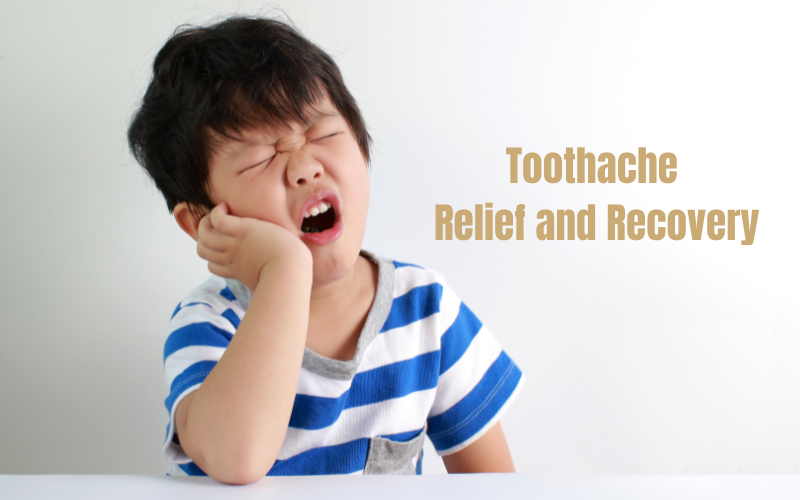Brentwood: (615) 235-1966

Toothache Relief and Recovery: Combining Antibiotics with Home Remedies
Brentwood, TN

Toothaches can stem from various factors, including dental decay, infection, gum disease, or trauma. The pain associated with a toothache can range from mild to severe, affecting eating, speaking, and even sleeping. Recognizing the signs and symptoms of a toothache is the first step toward addressing the issue and seeking appropriate treatment.
While antibiotics play a vital role in combating bacterial infections associated with toothaches, integrating them with home remedies can enhance the overall effectiveness of treatment. From natural remedies like saltwater rinses and cold compresses to prescribed medications, there are numerous ways to alleviate toothache symptoms and support dental recovery.
In this blog, we will explore these strategies in detail, providing insights into their benefits, precautions, and best practices for achieving toothache relief and promoting oral health.
Understanding Toothache Causes and Symptoms
A toothache can arise from various underlying issues, ranging from dental decay to trauma or infection. Understanding the common causes and symptoms associated with toothaches is essential for prompt treatment and relief.
Common Causes of Toothaches
- Dental decay: Tooth decay, also known as dental caries, is one of the leading causes of toothaches. When bacteria accumulate on the surface of the teeth, they produce acids that erode the enamel, leading to cavities and sensitivity.
- Gum disease: Periodontal diseases, such as gingivitis and periodontitis, can cause toothaches by affecting the supporting tissues around the teeth. Inflammation and infection of the gums can lead to gum recession, exposing the tooth roots and causing pain.
- Dental abscess: An abscessed tooth occurs when a bacterial infection reaches the pulp of the tooth, leading to the formation of pus and inflammation. This can result in severe pain and swelling around the affected tooth.
Symptoms Associated with Toothache
- Sharp or throbbing pain: Toothaches often manifest as sharp, stabbing pain in the affected tooth or surrounding areas. The intensity of the pain can vary from mild to excruciating, depending on the underlying cause.
- Sensitivity to hot or cold: Tooth sensitivity is a common symptom of toothaches, where the affected tooth reacts to temperature changes, such as hot or cold foods and beverages.
- Swelling and inflammation: Inflammation and swelling of the gums or surrounding tissues may accompany a toothache, indicating an underlying infection or abscess.
When to Seek Professional Help?
- Persistent pain: If the toothache persists for more than a couple of days despite home remedies or over-the-counter pain medications, it is advisable to seek professional dental care.
- Swelling or fever: Swelling, redness, or fever accompanying a toothache may indicate an infection that requires immediate attention from a dentist.
- Difficulty eating or sleeping: Severe toothaches that interfere with daily activities such as eating, speaking, or sleeping should prompt a visit to the dentist for evaluation and treatment.
Role of Antibiotics in Toothache Treatment
Antibiotics play a crucial role in the management of toothaches, especially when the underlying cause is a bacterial infection. Understanding how antibiotics work and their appropriate use is essential for effective toothache relief.
How Antibiotics Work to Combat Tooth Infection?
- Antibiotics target and kill the bacteria responsible for causing the infection in the tooth or surrounding tissues. By inhibiting bacterial growth and reproduction, antibiotics help to control the spread of infection and alleviate associated symptoms.
- Antibiotics may also reduce inflammation and swelling associated with tooth infections, providing additional relief from pain and discomfort.
Types of Antibiotics Commonly Prescribed for Toothaches
Penicillin: Penicillin antibiotics, such as amoxicillin, are frequently prescribed for dental infections due to their broad-spectrum activity against many types of bacteria commonly found in the oral cavity.
Clindamycin: Clindamycin is another antibiotic used for severe or resistant dental infections. It is effective against a wide range of bacteria and is often recommended for patients allergic to penicillin.
Metronidazole: Metronidazole may be prescribed in combination with other antibiotics to treat certain types of anaerobic bacteria commonly associated with dental abscesses.
Considerations Before Taking Antibiotics for Toothache Relief
- Proper diagnosis: Before antibiotics are prescribed, it is crucial for a dentist to diagnose the cause of the toothache accurately. Not all toothaches are caused by bacterial infections, and antibiotics may be ineffective or unnecessary for certain conditions.
- Antibiotic resistance: Overuse or misuse of antibiotics can lead to antibiotic resistance, where bacteria develop the ability to survive and multiply in the presence of antibiotics. Dentists consider the risk of antibiotic resistance when prescribing antibiotics and may opt for alternative treatments when appropriate.
- Side effects and interactions: Like any medication, antibiotics can cause side effects such as gastrointestinal upset, allergic reactions, or interactions with other medications. Patients should inform their dentist about any allergies or medical conditions before taking antibiotics for a toothache.
Home Remedies for Toothache Relief
When faced with a toothache, several home remedies can provide temporary relief from pain and discomfort:
Saltwater rinses: Gargling with warm salt water can help soothe pain and reduce inflammation around the affected tooth. The saltwater rinse acts as a natural disinfectant, helping to alleviate symptoms associated with toothaches.
Cold compress: Applying a cold compress or ice pack to the cheek over the affected area can numb the nerves and reduce swelling, providing temporary relief from toothache pain. Be sure to wrap the ice pack in a cloth to prevent direct contact with the skin and avoid ice burn.
Clove oil: Clove oil contains eugenol, a natural analgesic with numbing properties. Applying a small amount of clove oil to the affected tooth or gums can help alleviate toothache pain temporarily. However, clove oil should be used sparingly and diluted with a carrier oil to prevent irritation.
Combining Antibiotics with Home Remedies
When dealing with a toothache, combining antibiotics with home remedies can enhance the effectiveness of treatment and provide comprehensive relief. Here’s how:
Following the prescribed antibiotic regimen
It’s crucial to adhere to the prescribed antibiotic regimen provided by your dentist or healthcare provider. Completing the full course of antibiotics as directed helps eliminate the underlying bacterial infection causing the toothache and prevents the development of antibiotic resistance.
Complementing antibiotic treatment with home remedies
Home remedies such as saltwater rinses, cold compresses, and clove oil can complement antibiotic therapy by addressing pain and inflammation. While antibiotics work to eradicate infection, these home remedies can provide immediate relief from discomfort and promote faster healing.
Precautions when combining antibiotics and home remedies
It’s essential to use home remedies safely and in conjunction with antibiotic treatment. Avoid excessive use of home remedies or self-medication, as they may interfere with antibiotic effectiveness or cause adverse reactions. Always consult your dentist or healthcare provider before using home remedies alongside antibiotics, especially if you have any underlying health conditions or are taking other medications.
Toothaches can significantly impact daily life, but effective relief is achievable through a combination of antibiotics and home remedies. Understanding the causes and symptoms of toothaches, along with when to seek professional help, is crucial for prompt treatment. Antibiotics play a vital role in combating tooth infections, while home remedies offer additional relief from pain and inflammation. By following prescribed antibiotic regimens and safely integrating home remedies into the treatment plan, individuals can experience faster recovery and improved oral health.
However, it’s essential to exercise caution when combining antibiotics with home remedies, ensuring proper dosage and adherence to treatment guidelines. Consulting with a dentist or healthcare provider is paramount to receive personalized advice and avoid potential complications. With the right approach, toothache relief and recovery can be effectively managed, allowing individuals to regain comfort and functionality in their oral health.


